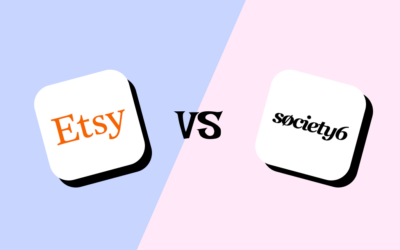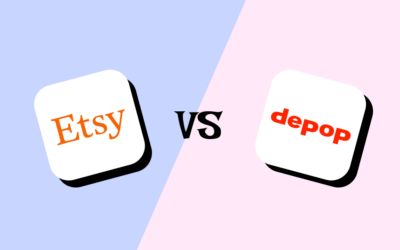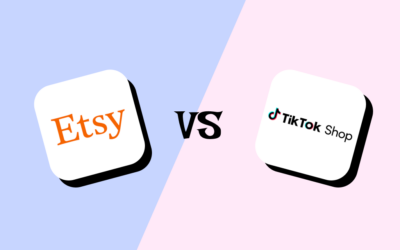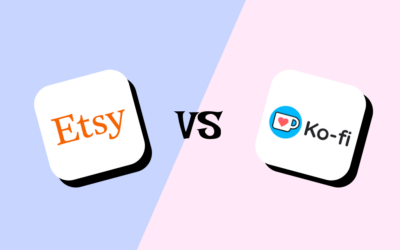Etsy vs Temu: They’re As Different As Chalk & Cheese!
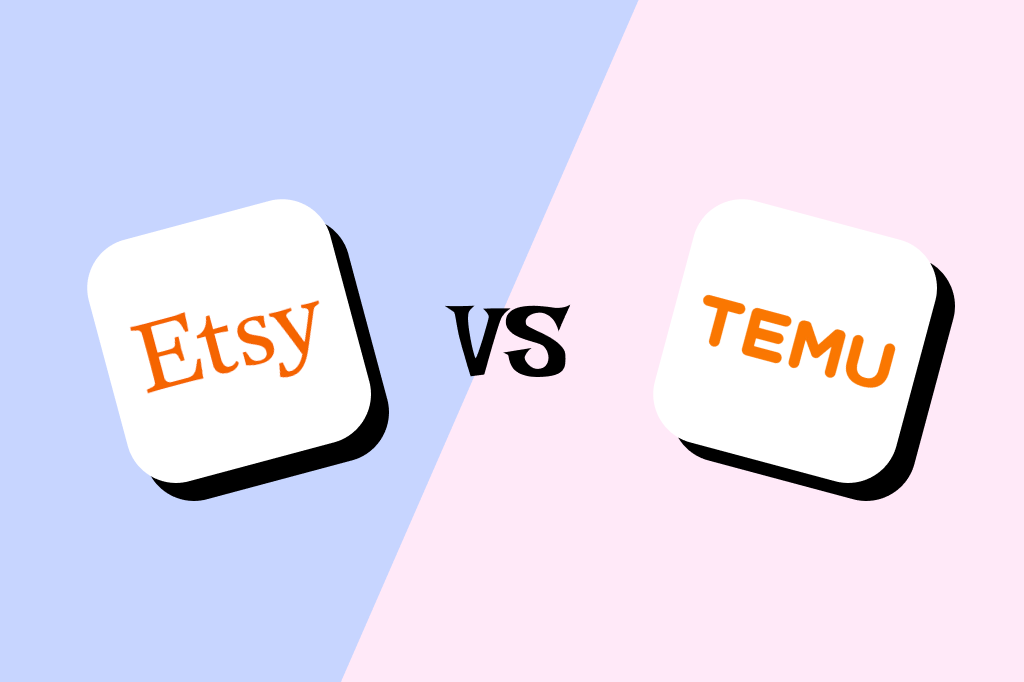
It has been only two years since Temu was introduced to the public, and yet, the Chinese-based eCommerce discount app has taken the United States by storm with its explosive growth. Therefore, choosing between Etsy vs Temu has been a heated than ever topic for seller-to-be worldwide.
But from the way we see it, Etsy and Temu are literally as different as chalk and cheese.
Okay, here’s why:
A quick look at Etsy vs Temu
Before we analyze the two platforms in greater detail, let’s take a glimpse at Etsy and Temu as well as their history, strengths, etc.
What is Etsy?
Etsy is a US-based eCommerce marketplace for crafts, vintage, and handmade items. Since its launch in 2005, Etsy has been among the most sought-after platforms for artists and small/local businesses worldwide to list and sell their art online.
With a specialized niche and product quality, Etsy has attracted a customer base of nearly 100 million active buyers from around the globe.
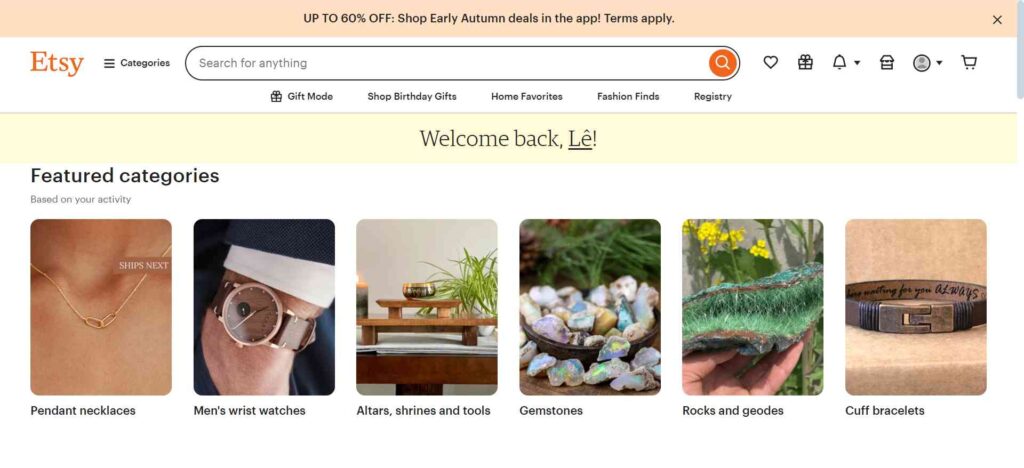
>> Relevant reading: How to Sell on Etsy for Beginners: 12 easy steps
What is Temu?
On the other hand, Temu is an online shopping app based in Boston, Massachusetts. However, its parent company is PDD Holdings, a group listed on the Nasdaq and also the owner of the highly popular eCommerce platform Pinduoduo in China.
Although it has only been around for two years instead of 20 years, like Etsy, Temu’s meteoric growth rate is genuinely awe-inspiring.
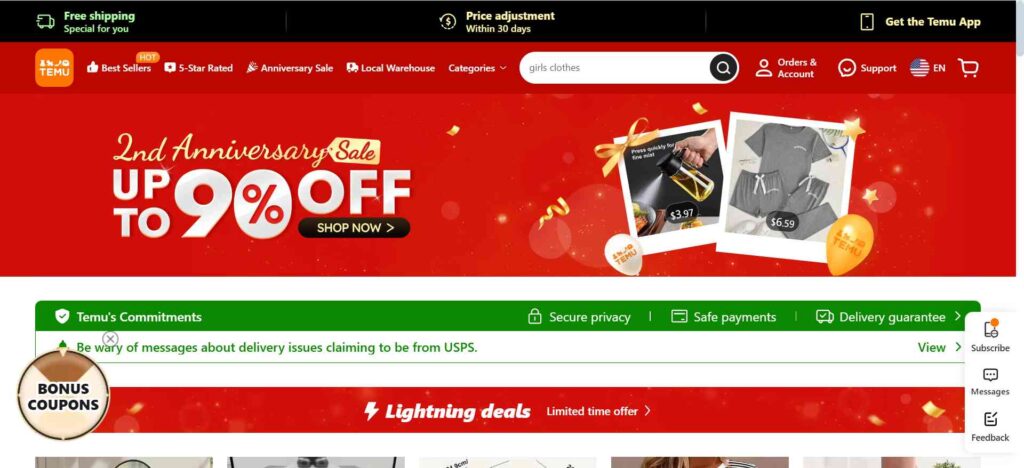
We believe this is all thanks to the company’s customer acquisition strategy: they basically use super competitive pricing to attract customers worldwide.
But how does Temu manage to keep their product prices that low– even lower than half of similar items on popular marketplaces like Amazon or eBay? We’ll cover it right below!
Temu vs Etsy: How do they stack up against each other?
Now that you have a grasp of what Etsy vs Temu is, let’s find out how they differ in the five most crucial aspects: model, product focus, selling requirements, costs, and shipping.
1. Strategy and direction
|
Key takeaways: Temu vs Etsy take entirely different growth strategies. Etsy leverages its specialized niche and quality commitment to acquire an engaging community. Meanwhile, Temu focuses on offering low-cost, mass-produced consumer goods straight from manufacturers to keep their prices as competitive as possible. |
Etsy’s strategy and direction
Etsy has been around for two decades, and yet the marketplace’s value proposition remains unchanged. Etsy defines itself as a marketplace where people can find quality, unique handmade items, gifts, vintage, collectibles, etc.
With the marketplace’s continued commitment to a niche audience (crafters, collectors, artists, etc.) from its first days, Etsy has acquired a very engaging community of sellers and buyers. We believe this is the core of Etsy’s steady growth and expansion strategy.
Temu’s strategy and direction
Unlike Etsy, Temu’s acquisition and marketing approach is entirely different. The company’s key growth-driven factor is pricing– as low as possible.
By selling goods directly from Chinese manufacturers to global customers, Temu cuts out intermediaries to offer maximum discounts. A women’s swimsuit on Temu is priced at just $6.50, and a pair of wireless earbuds costs $8.50. In fact, many items on Temu are priced under $1, such as sunglasses, eyebrow razors, and hair ties.
The core aspect of Temu’s model is that instead of buying products from a major brand like a Phillips electric toothbrush, consumers can now purchase an electric toothbrush directly from the manufacturer that makes them for Phillips, but at a much lower cost.
Due to Temu vs Etsy’s distinguishing focus, the two marketplaces are different in almost everything– which we’ll discuss next.
2. Product focus
|
Key takeaways: Etsy vs Temu has different product focuses. While Etsy solely specializes in handmade, vintage, gift, and creative arts, Temu’s product focus is much broader, which ranges across 250+ categories. |
Etsy’s product focus
As Etsy claims that they are a top marketplace for everyone to find quality handmade items, Etsy has a clear product focus, which mainly falls under:
-
- Handmade products like fashion, home decor, jewelry, etc.
- Vintage products at least 20 years old
- Craft supplies and do-it-yourself (DIY) products
- Personalized, custom gifts, such as custom T-shirts, mugs, canvas, etc.
- Digital products such as printable art, planners, social media banners, etc.
- Eco-friendly and sustainable items
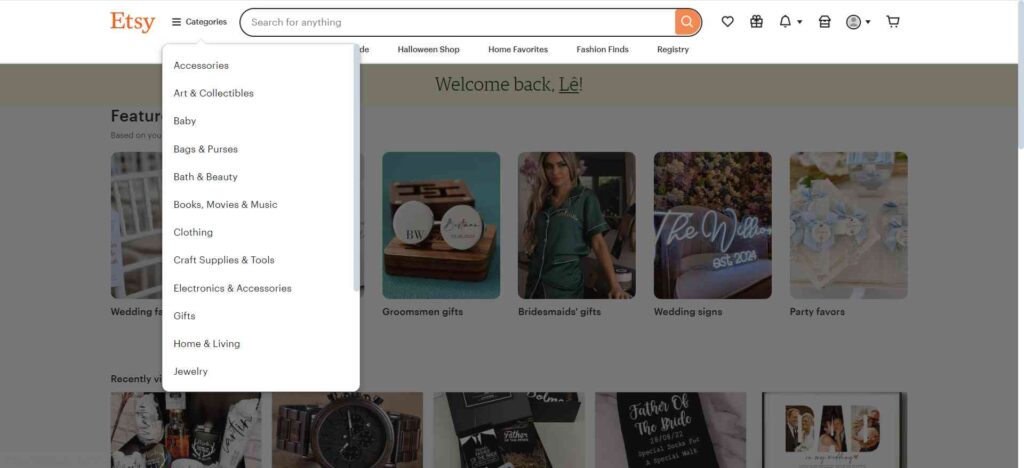
Temu’s product focus
Temu doesn’t have a specialized product focus like Etsy. Instead, it’s more like an online megastore where customers can shop for all kinds of products.
As of writing this article, there are over 250 product categories on Temu, spanning fashion, beauty, home decor, electronics and more. However, most of the items on the marketplace are still in the apparel niche.
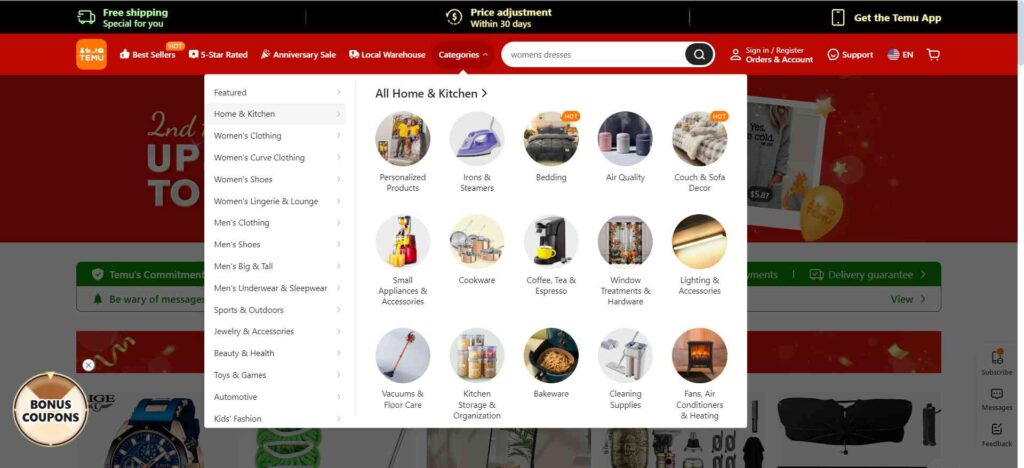
3. Selling requirements
|
Key takeaways: Temu has stricter selling requirements than Etsy. If you’re making your own crafts and live in one of the 60 countries supported by Etsy, you can sign up for an Etsy shop instantly. On the other hand, Temu currently only supports manufacturers coming from mainland China and Hong Kong. |
Etsy’s selling requirements
As long as your products meet Etsy’s handmade policy and you reside where Etsy Payments is supported, you can launch a shop on the marketplace.
Here are the details:
| Product Eligibility | Before thinking of opening an online shop on Etsy, ensure your products are not prohibited on the marketplace, which are: + Reselling wholesale items that do not meet Etsy’s handmade policy + Alcohol, tobacco, drugs, and drug paraphernalia + Live animals and certain animal products + Hazardous materials and items that pose safety risks + Hate items, illegal items, and pornography + Items that infringe on copyright or trademark laws |
| Seller Eligibility | After your products meet Etsy’s handmade and quality requirements, ensure you’re living in one of the 60+ countries supported by Etsy. |
Temu’s selling requirements
Unlike Etsy, Temu only supports sellers in mainland China or Hong Kong. Also, in order to list your products on Temu, you have to make sure they are not on the ‘blacklist’.
Here’s a summary of what Temu requires sellers to comply with to start selling on their platform:
| Product Eligibility | Similar to Etsy, Temu prohibits harmful and illegal items on their marketplace, which are: + Illegal substances, including drugs and narcotics + Weapons, firearms, ammunition, and items threatening public safety + Fake products, replicas, and unauthorized copies of branded items + Government-banned products per respective country + Items that are considered hazardous or illegal to transport + Adult products for certain buyers |
| Seller Eligibility | + Temu requires sellers to have a registered business in mainland China or Hong Kong + You have to be a manufacturer, not a re-seller or dropshipper |
4. Costs and fees
|
Key takeaways: Etsy’s fees are higher, but the actual cost is higher with Temu. Yup, you heard it right. Temu seemingly charges you fewer and lower selling fees. Nevertheless, to remain competitive on Temu, you have to keep your product prices at ultra-low levels, which will surely cut into your profit margin. |
Etsy’s costs and fees
Etsy charges you three main fees for selling crafts on their marketplace: listing fees, transaction fees, and payment processing fees.
Imagine you are selling handmade candles on Etsy. Here’s how the fees would apply:
Listing fee:
- Base: You list a candle for sale on Etsy. For this, you pay a base fee of $0.20
- Auto-renewal: If you set your listing to renew every time your candle is sold automatically, you will be charged an additional $0.20 each time the listing renews after a sale.
- Multi-variant: Suppose your candle comes in three different scents (e.g., lavender, vanilla, and citrus). Etsy treats each scent as a separate product. So, if you list all three scents, you pay $0.20 for each, totaling $0.60 for the multi-variant fee.
- Private listing: If a customer requests a custom candle and you create a private listing just for them, Etsy charges you $0.20 for this private listing.
Transaction fees: Etsy will charge you a referral fee of 6.5% of the total amount in your listing currency
Payment processing fees: This fee is a standard 3% + $0.25 in the US and varies by countries
Temu’s costs and fees
Unlike Etsy, Temu is not so upfront about the costs and fees for merchants to sell products on their platform. However, from what we know, the following are a few main selling fees you need to factor in if you plan to sell on Temu:
Commission fees: Temu charges you a commission fee, aka referral fee, on each sale. This fee typically falls between 2% and 5% of the item’s selling price, depending on your product category and price range.
Transaction fees: You are charged a small transaction fee of 0.3% per successful transaction happening on Temu
Payment processing fees: Temu partners with Stripe for payment processing, which charges you a standard fee of 2.9% + $0.20 per transaction
With the cost structure above, does Temu generally cost you less to sell compared to Etsy? Well, think again.
It’s true that the selling fees on Temu are a bit lower than on Etsy. However, the only way to survive and thrive on Temu is by offering its price-sensitive customers the lowest price possible. This will eat deeply into your profit margin if you don’t have a super-optimized production line.
5. Shipping and logistics
| Key takeaways: Both marketplaces have great shipping and logistics support. Both Temu vs Etsy have strong shipping and logistics support, allowing sellers to ship products quickly to buyers at rational shipping fees. |
Etsy’s shipping and logistics
Etsy has implemented several features to simplify shipping and fulfillment for you as a seller. One of the most significant advantages is the availability of subsidized shipping labels, which can save you up to 30% compared to shipping directly with carriers like USPS, FedEx, and Canada Post.
To streamline the process further, Etsy even allows you to purchase and print shipping labels directly from your shop. Once a label is purchased, your order will be automatically marked as shipped, and you can print the label for delivery.
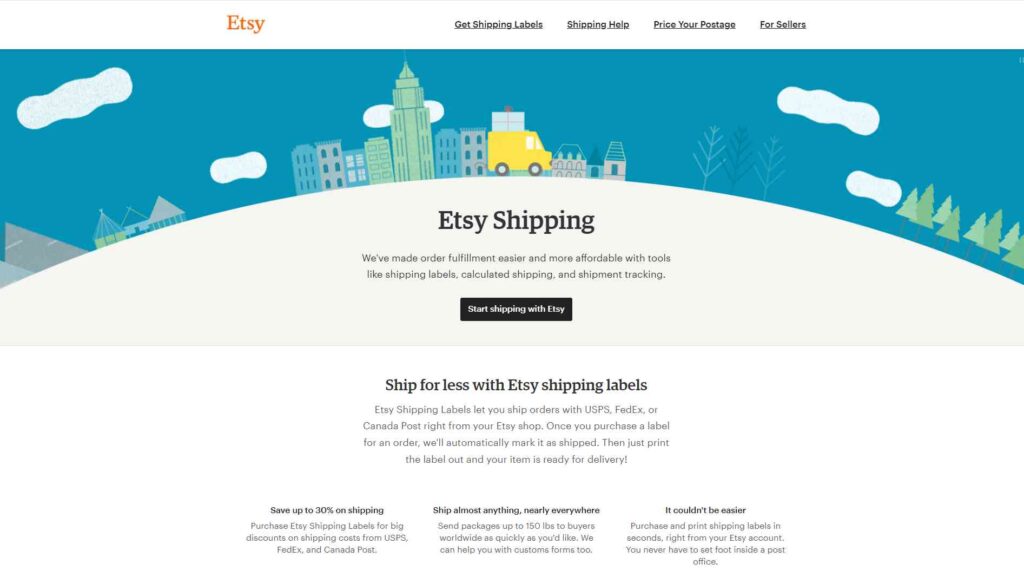
Temu’s shipping and logistics
Similar to Etsy, Temu allows sellers to create and manage their own shipping carriers and methods, giving them complete control of the shipping process. The Chinese marketplace also works with leading carriers like UPS, FedEx, and USPS to ensure all orders are shipped within 4-22 days, depending on customers’ shipping method and cart value.
>> Relevant reading: 14 Etsy Alternatives to Sell Your Crafts Online
Etsy or Temu: Which is better
Pros and cons of Etsy
| Pros | Cons |
| + Etsy is well-known for its artisanal focus + The marketplace has an extensive built-in audience of over 96 million active buyers + Etsy supports sellers in over 60 countries |
– The increasing competition within the Etsy marketplace can make it difficult to stand out – Etsy charges 6.5% transaction fees, which can add up to cost for large volume stores |
Pros and cons of Temu
| Pros | Cons |
| + Its growth rate in customer base is remarkable + Temu offers low commission rates, making it cost-effective for sellers to list products + It’s suitable for manufacturers who can offer competitive pricing |
– Temu is only eligible for manufacturers residing in mainland China or Hong Kong. – The marketplace’s ultra-low pricing means your profit margin will be razor-thin. – Some customers find Temu’s constant promotions and pop-ups overwhelming |
Wrapping up
All in all, Etsy vs Temu are both popular eCommerce marketplaces worldwide. However, after reading this article, we believe it’s clear that the two platforms are different from each other in all possible aspects– their strategy, audience, and more.
Etsy should be your go-to choice if you are an artist, a crafter, or anyone who loves to create crafts, gifts, or DIY items and is looking for a marketplace with an engaging community to sell your handmade stuff.
Meanwhile, you would shine on Temu if you are a manufacturer living in the regions where Temu is supported and can afford a thin profit margin to compete with other sellers on the platform.
Frequently asked questions
Does Temu compete with Etsy?
Yes, but not directly. What we mean by that is Etsy vs Temu cater to different types of sellers:
– Temu primarily targets manufacturers offering a wide range of products
– Etsy focuses on handmade, vintage, and craft supplies.
Which country uses Etsy most?
Per statistics by Similarweb, more than half of Etsy’s traffic is from users living in the United States, at 58.79%.
Who is Etsy's biggest competitor?
Etsy’s biggest competitor is Amazon Handmade, which is also a giant eCommerce marketplace that is popular in the US and worldwide.

